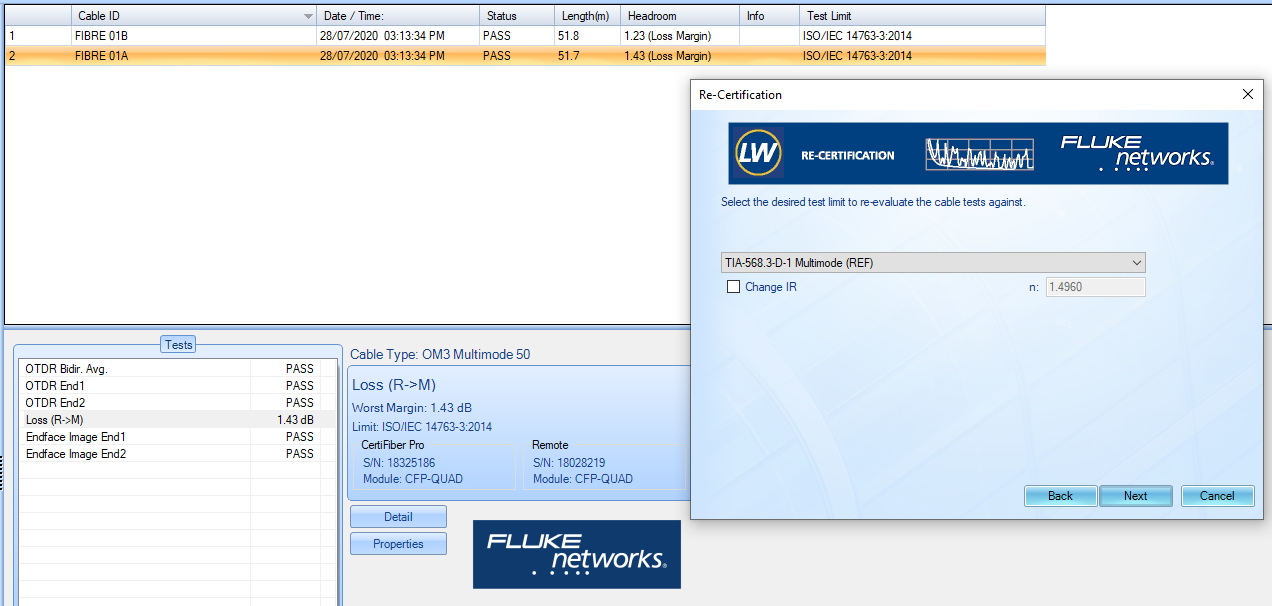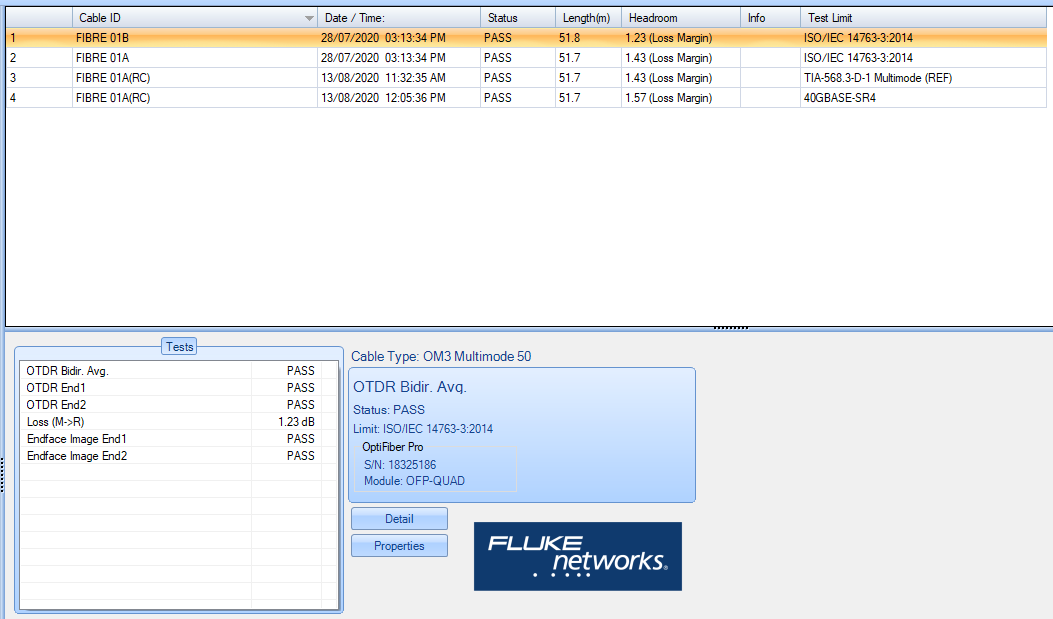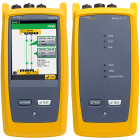Re-Certified Test Reports - Part 2 - Fiber Optic Tests
August 20, 2020 / General, Installation and testing, Industrial Networks, Best Practices
Part 2 of a series - for part 1, click here.
In my last article we looked at the re-certification of twisted pair copper test results. A consultant I often work with had some doubts about re-certified results that we were able to dispel.
The answer I gave got my consultant friend thinking about fiber optic test results, can they be re-certified as well? He gets a lot of reports where the fiber has been tested to ISO/IEC 14763-3:2014 limits, whereas he often requires fiber to be tested to ANSI/TIA-568.3-D-1 requirements.
In a nutshell, yes, with Fluke Networks CertiFiber® Pro Optical Loss Test Set (OLTS) results obtained using one test limit can be re-certified to another limit. There is a proviso, provided we have all the required data to re-certify.
With fiber testing, loss is loss no matter which standard is used for the initial testing. Provided you know how the original measurement was made with an OLTS, you can take the measured values, apply the measurement setup and recalculate your new acceptable pass / fail limits. You can then compare these new limits against the original measured results and evaluate whether the results are still a pass or if they are now a fail against new limits.
With Fluke Networks CertiFiber Pro OLTS, when you save the measurement, not only are the measurement values saved, but all the setup parameters that were used to make that measurement are also saved.

Figure 1. The measured result from the OLTS and the values that were setup to make the measurement
In Figure 1 above, we can see the measured result for a test carried out to the requirements of ISO/IEC 14763-3:2014. If we tap the SETTINGS soft button, we can see the setup selected by the testing technician, right hand screen image.

Figure 2. Our budget calculation for 850nm using ISO/IEC 14763-3:2014 requirements.
We know the fibre type, we know the reference method and critically, we know how many connectors and splices were set. From the measurement we know the length of the fiber. Our budgets are always calculated from connector losses, plus splice loses plus loss of the fiber.
If we refer to the budget calculations above in Figure 2, we have a limit value of 1.79dB. Our measured result was 0.33dB (shown in Figure 1 left image), hence we have a positive margin of 1.46dB and our link passes the insertion loss test using the OLTS.

Figure 3. Our budget calculation for 850nm using ANSI/TIA-568.3-D-1 requirements.
What if our technician was supposed to use the ANSI/TIA-568.3-D-1 test limits for testing? Why don’t we go ahead and apply those limits to our obtained test result?
Comparing the two charts, we can see that there is only 0.03dB difference in using either the ISO/IEC 14763-3:2014 test limits or the ANSI/TIA-568.3-D-1 test limits. Handy if you need to confirm that 40GBASE-SR4 will work on a previously installed 10GBASE-SR link. No retesting required!
If you have all the necessary data, you can re-certify fiber optic test limits to other fiber test limits using Fluke Networks CertiFiber OLTS and our LinkWare® PC Results Management Software.
Let’s now look at that process in LinkWare PC.

Figure 4. Our original test result selected to be recertified to TIA-568.3-D-1 (REF)
We highlight the original result we are interested in, from LinkWare PC’s Utilities menu we select Re-Certify and select the new test limit from the list of standards available. Tap NEXT and LinkWare PC will do the recalculations. Tap Finish to complete the process. LinkWare will add the re-certified result(s) into the results window with an (RC) appended to the Cable ID to denote that the result is a re-certified result.

Figure 5. Our re-certified results shown with the (RC) indicators at the bottom of the results list.
A re-certified result from a Fluke Networks CertiFiber Pro OLTS can be fully trusted as being a valid test result for the link that was installed. The raw data was not manipulated at all, just evaluated against the new limit that was selected, for all required tests. A re-certified test result cannot be manipulated, the limits for the standards used in the re-certification have been coded by Fluke Networks engineers with reference to the appropriate standards. A user has no way to access this data and modify it, when using Fluke Networks LinkWare PC software.
Fluke Networks LinkWare PC is trusted by OEMs and consultants worldwide. The format of the files generated is .flw (Fluke LinkWare), the file format is robust and can’t be manipulated or hacked. In fact, if someone attempts to manipulate the file, LinkWare will either report the file as being corrupted or, will revert the file back to its original, untampered state so the original test result can be seen.






